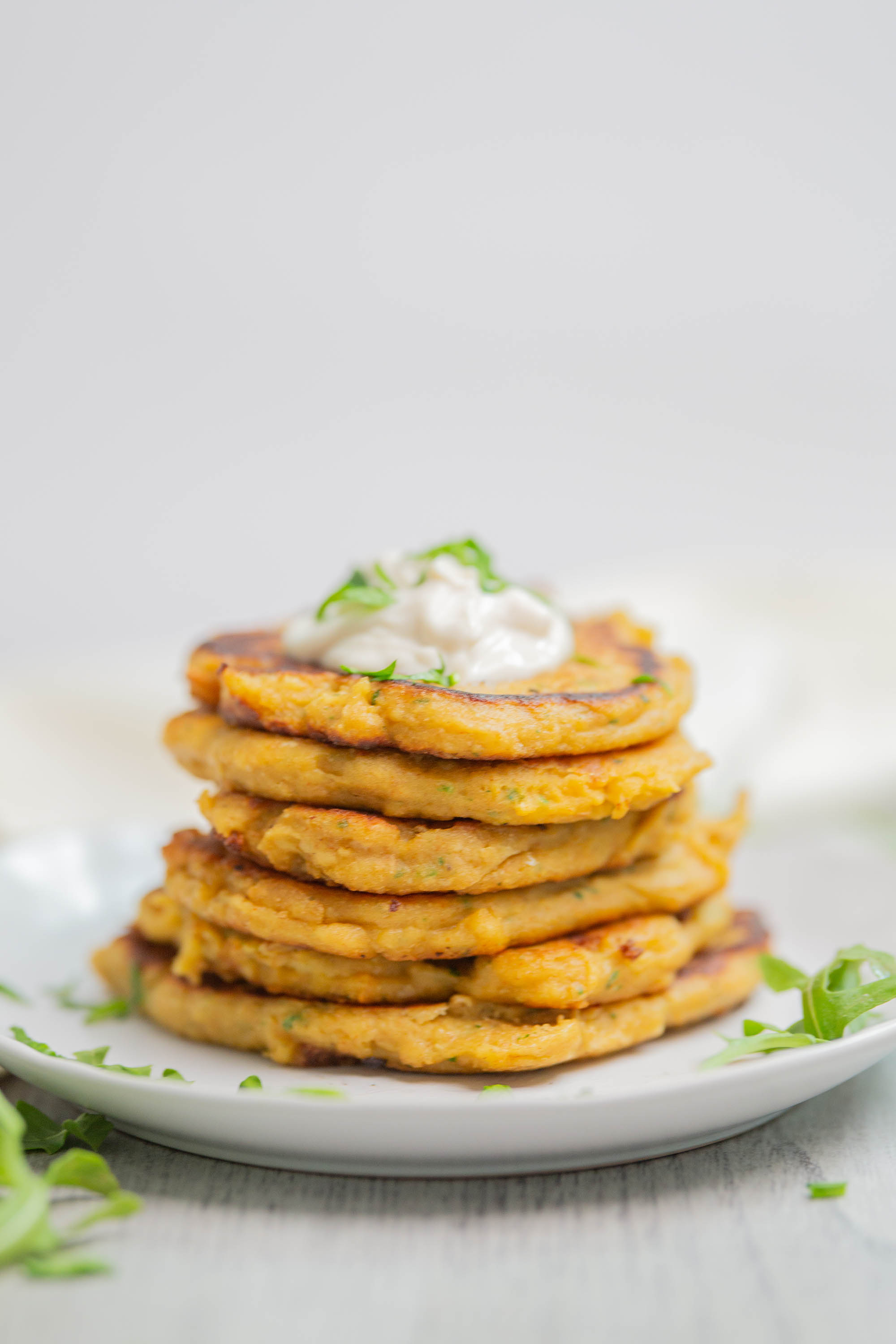I am currently running a blood sugar series on Instagram and have been thinking up recipes that include resistant starch. Resistant starch acts like soluble fibre in the gut and is powerful at helping to lower blood sugar. It is so good at flattening the blood sugar curve that it is known to have second meal affect. This means that eating resistant starch in one meal will not only lower the glucose response of that meal but will also lower it for the next meal, even if no resistant starch is consumed in the second meal. You can read more about the benefits of resistant starch here.
One of the best ways to get resistant starch is through cooking and then cooling potatoes. This increases resistant starch anywhere from 30- 90% and the benefits only increase if the potatoes are cooked again. Potatoes can be a problem food for many people because they are a high carbohydrate food, but knowing how to prepare them in a way that is better for blood sugar can help a lot of people enjoy the benefits of potatoes without the blood sugar spike.
Personally I have always eaten a lot of potatoes. They are a staple food in my culture and are quite possibly one of my most favourite foods in the world. We have potatoes a few times a week. Every Friday, I boil a big batch of potatoes which we then cool in the fridge and cook up again over the next couple of days. Today I decided to turn a few of my left over boiled potatoes into these savoury lentil and potato pancakes. I first got this idea after eating a lentil and potato pancake at one of my favourite vegan cafes. I was not able to reproduce the recipe but my version is still yummy. These pancakes are very filling and dense. They can be consumed as a savoury breakfast but personally I prefer them for lunch. The pancakes also remind me of fritters. They would work really well shaped into smaller fritter patties and enjoyed with a huge side salad too.
The recipe is vegan, has no eggs or dairy and can easily be made gluten free depending on what flour is used.



| Lentil Potato Pancakes | Print |
- 3 medium pre-boiled potatoes
- 2 cups pre-cooked red lentils (1/2 cup dry boiled in 2 cups water)
- ½ onion
- 2 tsp smoked paprika
- 2 TBSP chopped spinach
- ½ tsp salt or to taste
- ½ cup wholemeal spelt flour or flour of choice
- ¼ cup plant milk
- ½ cup grated vegan or normal cheddar cheese (optional)
- Add all ingredients into a food processor and process until a sticky batter forms.
- Use ½ cup measurements and place onto an oiled fry pan. I use avocado oil. The batter is gooey and may need some shaping.
- Fry for a few minutes until the base becomes golden then flip using a spatula to fry the other side. Repeat until batter is finished.
- Serve with some vegan sour cream or yogurt, fresh herbs and a large side salad.
- *you can add any additional herbs and spices to flavour these pancakes as desired











Thank you for sharing your information on resistant starch. I cannot wait to try your lentil potato pancakes. I have extensively analyzed the resistant starch evidence and had to comment that the vast majority of clinical studies showing health benefits used resistant starch as supplements. Very few studies have used foods alone – primarily because it is difficult to control the amount of resistant starch but also because foods contain lower levels than shown to deliver significant health benefits. From my records, approximately 52% of the 352 published clinicals used resistant corn starch (including Hi-maize resistant corn starch, high amylose corn flour, etc.), 17% used resistant green banana starch (mostly handmade by the researchers), and 10% used resistant potato starch. Only 14 clinical studies used beans/peas/legumes that I can find. The stronger health benefits are seen with higher resistant starch consumption (minimum 15 g/day to more than 40 grams/day). Only satiety and regularity are seen with lower doses (8 g/day-10 grams/day).
When resistant starch flours are cooked and cooled, the vast majority of the resistant starch is lost because the starch granule cooks out. Some RS3 is formed, but the levels are much lower. For instance, raw green banana starch can contain 60-55% resistant starch but cooked green banana starch likely contains less than 5% resistant starch. Improving insulin sensitivity (through changing the expression of the genes within the large intestine that controls peripheral insulin sensitivity) required 15 g/day for overweight men and 30 grams/day for women. It is tremendously difficult to consume these levels without supplementing with a concentrated resistant starch.
I would be very interested in additional information on the type of resistant starch that gave you such difficulty – was it chemically modified? There is clear scientific evidence that chemically modified resistant starches are digested differently and fermented differently than the natural resistant starches. Perhaps the distinction between chemically modified resistant starches and natural resistant starches would be more useful than suggesting that only food sources should be utilized.
Wow that was an incredibly thorough research and comment. Thank you for taking the time to do that. I am going to screen shot that for reference! In my case, I believe I had such a strong reaction because I did not need it ( I took it by mistake). My blood sugar was already very low and I was breastfeeding at the time which made it even lower than usual. So for me, it tipped me over the edge and I got very bad hypoglycemia episodes which were kind of scary. I do not know what type of resistant starch is was, I don’t think it was natural like “green banana flour” the ingredients just said “resistant starch” it was part of a breakfast bar I was snacking on. I have always assumed it was synthetic but I do not know. I think my point is that, you can find resistant starch in foods and increase the amount by cooking and cooling, although no where near as much as a concentrated resistant starch. So to your point, if you have insulin resistance/diabetes, food alone probably isn’t going to offer therapeutic benefit, but it can help somewhat lower the post – prandial glucose response which can just help you feel better and somewhat lower the GI of the food in question. I agree, it isn’t a strong effect, and its very hard to measure, but it may offer some minor benefits. For me, I have never had a bad reaction from any foods containing resistant starch and have found that the cooking and cooling thing has helped to lower post blood sugar spike (by means of, I don’t get as lethargic after a carb heavy meal). I hope that helps answer your question. Someone who has high glucose/insulin would not react the same as I did. I am also extremely sensitive to most supplements, even natural ones, so I tend to just try foods whenever possible because I react to anything isolated and concentrated, but thats just me.